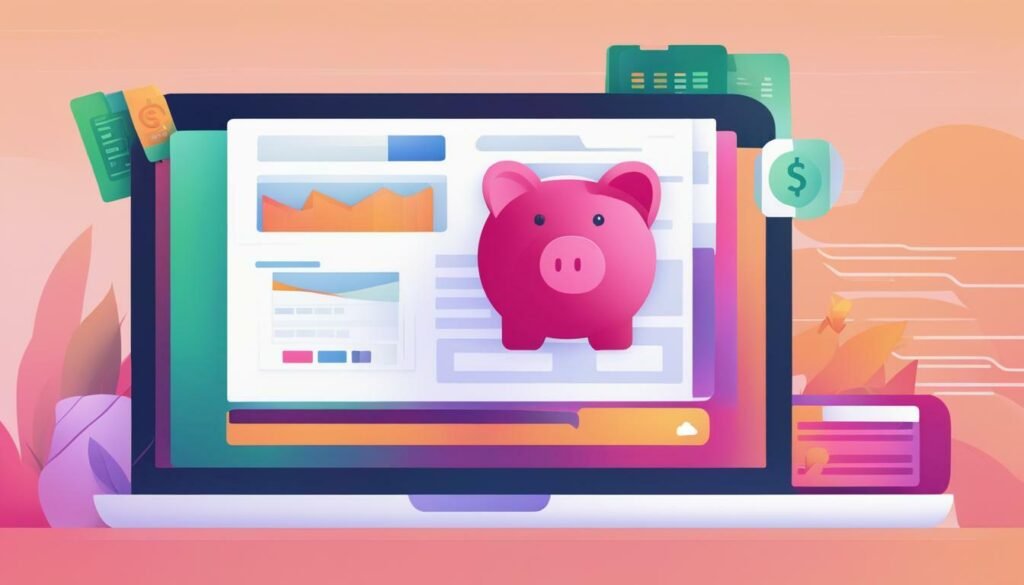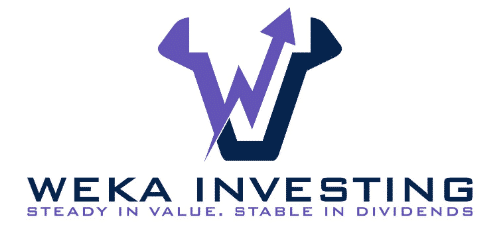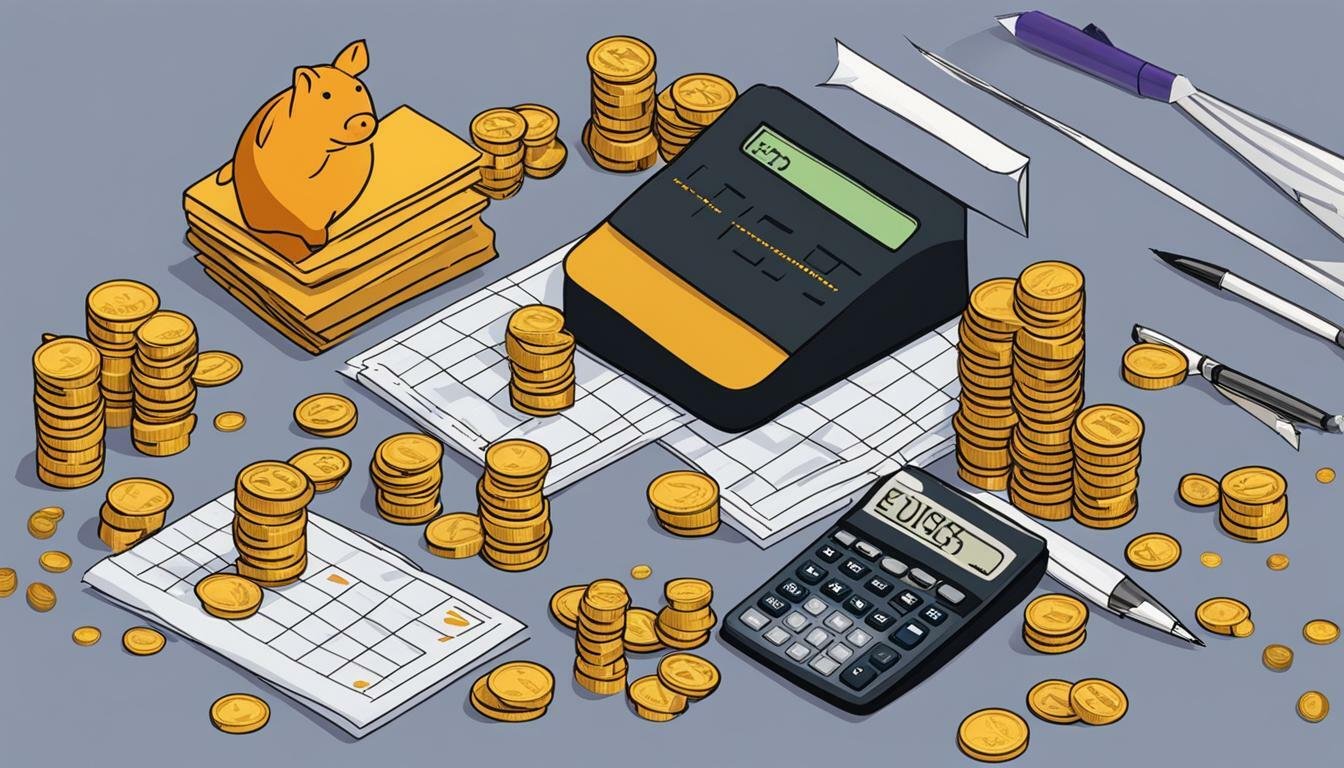Budgeting for Dividends: 5 Tips for Making Your Money Work for You
Budgeting for dividends is a crucial aspect of financial planning that allows you to maximize your income and make your money work for you. It involves creating a budget, getting out of debt, opening a high-yield savings account, considering passive income streams, and investing wisely. By implementing these strategies, you can optimize your personal finances and achieve long-term financial stability.
Key Takeaways:
- Creating a budget is essential for effective financial management.
- Getting out of debt is crucial in order to maximize your financial resources.
- Opening a high-yield savings account can help grow your savings more efficiently.
- Considering passive income streams can supplement your budgeting efforts.
- Investing wisely and diversifying your portfolio are key strategies for long-term financial success.
The Benefits of Budgeting for Dividends
Budgeting for dividends offers numerous advantages, including financial stability, passive income generation, and the ability to achieve long-term financial goals. By implementing a well-structured budget that incorporates dividend income, individuals can effectively manage their personal finances and make their money work for them.
One of the key benefits of budgeting for dividends is the attainment of financial stability. Dividend income provides a consistent and reliable source of earnings, allowing individuals to better plan and manage their monthly expenses. By incorporating dividend payments into their budget, individuals can have a more accurate assessment of their available funds and make informed financial decisions.
Another advantage of budgeting for dividends is the potential for passive income generation. Dividends are a form of passive income that can be earned by investing in dividend-paying stocks or funds. By budgeting for dividends, individuals can build a passive income stream that grows over time, providing them with additional financial security and the freedom to pursue their long-term financial goals.

Table 1: Summary of the Benefits of Budgeting for Dividends
| Advantages | Description |
|---|---|
| Financial Stability | By incorporating dividend income into their budget, individuals can achieve a more stable financial situation and better manage their monthly expenses. |
| Passive Income Generation | Budgeting for dividends allows individuals to build a passive income stream that grows over time, providing them with additional financial security. |
| Long-Term Financial Goals | By budgeting for dividends, individuals can work towards achieving their long-term financial goals, such as retirement or purchasing a home. |
In conclusion, budgeting for dividends is a powerful strategy for effectively managing personal finances. It offers benefits such as financial stability, passive income generation, and the opportunity to achieve long-term financial goals. By incorporating dividend income into a well-structured budget, individuals can optimize their finances and make their money work for them.
Creating an Effective Budget
To budget for dividends successfully, it is essential to create a comprehensive budget that includes saving tips, promotes financial discipline, and accurately tracks expenses. A well-designed budget acts as a roadmap for managing your personal finances and ensuring that your money is working for you.
Here are some key steps to help you create an effective budget:
- 1. Set financial goals: Start by identifying your short-term and long-term financial goals. Whether it’s saving for a down payment on a new home, paying off debt, or building an emergency fund, clearly defining your goals will give your budget purpose.
- 2. Track your expenses: Keep a record of all your expenses, big and small. This will help you identify areas where you can cut back and save. Use a spreadsheet, a budgeting app, or a pen and paper – find a method that works best for you.
| Expense Categories | Monthly Budget Allocation |
|---|---|
| Housing | $1,200 |
| Transportation | $400 |
| Utilities | $200 |
| Groceries | $300 |
| Entertainment | $150 |
3. Prioritize saving: Make saving a top priority in your budget. Allocate a specific portion of your income towards savings every month. Consider automating your savings by setting up automatic transfers to a separate savings account. This will help you stay consistent and build your savings over time. Remember, even small contributions can add up.
4. Practice financial discipline: Stick to your budget and avoid unnecessary impulse purchases. Differentiate between wants and needs. Before making a purchase, ask yourself if it aligns with your financial goals. Developing disciplined spending habits will help you stay on track and make progress towards your financial objectives.
By following these steps and creating an effective budget, you can take control of your finances, save for dividends, and make your money work for you. Stay committed to your budgeting goals and regularly review and adjust your budget as needed to ensure continued financial success.

A vital aspect of budgeting for dividends is getting out of debt, which involves strategic debt consolidation, prioritization, and maintaining financial discipline. Debt can significantly impact your financial stability and hinder your ability to make your money work for you. By addressing your debt effectively, you can free up resources to invest in dividend-paying assets and create a solid foundation for your financial future.
One strategy to consider is debt consolidation, where you combine multiple debts into a single loan with a lower interest rate. This can simplify your repayment process and potentially reduce the overall interest you pay. Prioritizing your debts is another crucial step in debt reduction. Start by focusing on high-interest debt first, as it can accumulate quickly and strain your finances.
Financial discipline plays a key role in getting out of debt and staying debt-free. It requires a commitment to living within your means, avoiding unnecessary expenses, and consistently making payments on time. Creating a budget and tracking your expenses can help you identify areas where you can cut back and redirect those funds toward debt repayment. Making small sacrifices now can lead to significant financial gains in the future.
Debt Repayment Strategies:
- Consolidate high-interest debt for lower monthly payments.
- Prioritize debt with the highest interest rates.
- Stick to a budget and track your expenses.
- Reduce discretionary spending to allocate more funds toward debt repayment.
- Create an emergency fund to avoid relying on credit for unexpected expenses.
- Consider credit counseling or debt management programs for professional assistance.
Remember, getting out of debt is a journey that requires patience and discipline. Stay committed to your financial goals, and over time, you will experience the freedom and peace of mind that comes with being debt-free.
| Debt Repayment Strategies | |
|---|---|
| Consolidate high-interest debt | Combine multiple debts into a single loan. |
| Prioritize high-interest debt | Tackle debt with the highest interest rates first. |
| Stick to a budget | Create a budget to track your income and expenses. |
| Reduce discretionary spending | Identify areas where you can cut back on unnecessary expenses. |
| Create an emergency fund | Build a safety net to avoid relying on credit for unexpected costs. |
| Consider professional assistance | Explore credit counseling or debt management programs for guidance. |

Opening a High-Yield Savings Account
Incorporating a high-yield savings account into your budgeting for dividends strategy can contribute to more substantial savings growth, and we will explore the steps to open and maintain one. A high-yield savings account offers a higher interest rate compared to traditional savings accounts, allowing you to earn more on your money over time. This can be particularly beneficial when you are focused on generating income through dividends and maximizing your financial resources.
When considering opening a high-yield savings account, it is important to research and compare different financial institutions to find the best rates and terms. Look for accounts that offer competitive interest rates and low fees. You can often find online banks and credit unions that provide higher yields and better savings options than traditional brick-and-mortar banks.
Once you have chosen a suitable financial institution, the process of opening a high-yield savings account is relatively straightforward. Most banks have online applications that allow you to provide your personal information, including your address, social security number, and employment details. Additionally, you may need to deposit an initial amount to activate the account.
Once your high-yield savings account is open, it is crucial to maintain financial discipline to maximize its potential. Set up automatic transfers from your checking account to your savings account on a regular basis. This ensures that a portion of your income is consistently directed towards savings, helping you build your dividend portfolio and achieve your financial goals. Regularly monitor your account balance and any changes in interest rates or fees to ensure you are getting the most out of your high-yield savings account.
| Benefits of Opening a High-Yield Savings Account: |
|---|
| 1. Higher interest rates compared to traditional savings accounts. |
| 2. Easy accessibility to funds whenever needed. |
| 3. Potential for compound interest growth. |
| 4. Lower fees and better terms than brick-and-mortar banks. |
Opening a high-yield savings account is a strategic move when budgeting for dividends. By harnessing the power of compounding interest and maximizing your savings growth, you can enhance your financial stability and set the stage for future wealth creation.
Key Steps to Open a High-Yield Savings Account:
- Research and compare financial institutions to find the best rates and terms.
- Complete the online application, providing necessary personal information.
- Deposit an initial amount to activate the account.
- Set up automatic transfers to consistently contribute to your savings.
- Monitor your account balance and any changes in interest rates or fees.
Incorporating a high-yield savings account into your budgeting for dividends strategy can provide a significant boost to your savings growth. By taking the time to choose the right account, opening with a reputable institution, and maintaining financial discipline, you can make the most of this powerful tool in achieving your financial goals.

When budgeting for dividends, it is essential to consider passive income streams, such as rental properties, investments, or online ventures, to diversify your income sources and enhance your financial stability. Passive income refers to money earned with minimal effort or active involvement, providing you with a consistent stream of cash flow that can supplement your regular earnings and contribute to your overall financial well-being.
One popular passive income stream is rental properties. Owning and renting out real estate can generate a reliable source of income through monthly rental payments. By carefully selecting properties in desirable locations and managing them effectively, you can build a portfolio of rental properties that generate consistent returns over time.
Another passive income stream is investments such as dividend stocks or bonds. By investing in dividend-paying stocks, you can earn regular income through the dividends distributed by the companies. Bonds also provide a steady source of passive income through interest payments. It is important to research and analyze different investment options to make informed decisions that align with your financial goals.
| Passive Income Stream | Description |
|---|---|
| Rental properties | Owning and renting out real estate for monthly rental income. |
| Investments | Earning passive income through dividend stocks or bonds. |
| Online ventures | Generating income through e-commerce, affiliate marketing, or online courses. |
Lastly, online ventures offer opportunities to generate passive income. With the rise of the internet, various online business models have emerged. E-commerce, affiliate marketing, and online courses are just a few examples of how you can leverage the digital space to create passive income streams. These ventures require upfront effort and investment, but once established, they can generate income even while you’re sleeping.

Incorporating passive income streams into your overall financial plan can provide stability and diversify your income sources. However, it is essential to note that passive income does require initial effort and ongoing management. By strategically choosing the right passive income streams for you, you can enhance your financial stability and make your money work for you.
Wise Saving and Investing
Wise saving and investing play a crucial role in budgeting for dividends, and we will delve into various investment strategies, financial goal-setting, and actionable saving tips to optimize your financial plan. When it comes to investing, diversification is key. By spreading your investments across different asset classes, such as stocks, bonds, and real estate, you can reduce risk and increase your chances of earning steady returns. , and regularly review and adjust your portfolio based on market conditions and your financial goals.
It’s also important to set clear financial goals when budgeting for dividends. Whether you’re saving for retirement, a down payment on a home, or a dream vacation, having specific goals in mind helps you stay focused and motivated. Break down your goals into smaller, actionable steps, such as saving a certain percentage of your income each month or increasing your contributions to your retirement account. This will not only make your financial goals more achievable but also give you a sense of progress and accomplishment along the way. Remember, each small step counts towards the bigger picture.
To make the most of your savings, it’s essential to implement effective saving strategies. Consider automating your savings by setting up automatic transfers from your checking account to a high-yield savings account. This not only ensures consistent savings but also takes advantage of compounding interest, allowing your money to grow over time. Additionally, explore different saving options such as certificates of deposit (CDs) or money market accounts, which offer higher interest rates compared to traditional savings accounts. By being proactive and disciplined in your saving habits, you can maximize the growth potential of your funds.

Investment Strategies
When it comes to investment strategies, it’s important to align your investments with your financial goals and risk tolerance. If you’re looking for long-term growth and are comfortable with market fluctuations, consider investing in low-cost index funds or exchange-traded funds (ETFs) that track broad market indices. These passive investments offer diversification and tend to perform well over time. On the other hand, if you prefer a more hands-on approach and have a higher risk tolerance, you may explore individual stocks or real estate investment trusts (REITs) that offer the potential for higher returns but also come with greater risk.
Another strategy to consider is dollar-cost averaging. Instead of trying to time the market, this approach involves investing a fixed amount regularly, regardless of market conditions. By doing so, you can take advantage of market downturns and accumulate more shares when prices are low, effectively lowering your average cost per share over time. This strategy helps mitigate the impact of short-term market volatility and allows you to build a diversified portfolio systematically.
| Investment Strategy | Risk Level | Returns |
|---|---|---|
| Index funds/ETFs | Low | Steady long-term growth |
| Individual stocks | High | Potentially high returns |
| REITs | Medium to high | Income generation and potential growth |
Remember that investing involves risks, and it’s important to do thorough research and consider seeking professional advice before making any investment decisions. Your financial journey is unique, and what works for others may not necessarily work for you. Take the time to assess your risk tolerance, financial goals, and investment horizon so you can tailor your investment strategy accordingly. By investing wisely and regularly reviewing your portfolio, you can optimize your financial plan and make your money work for you.
Automating Bill Payments and Savings
Automating bill payments and savings is an effective method to enhance financial discipline and ensure consistent growth of your savings, which is vital when budgeting for dividends. By setting up automatic payments for your bills, you can eliminate the risk of late fees or missed payments, helping you maintain a good credit score and reducing financial stress. Additionally, automating your savings transfers allows you to consistently contribute to your savings account without having to remember to do it manually.
With the advancement of technology, most banks and utility companies offer automatic payment options, making it convenient and hassle-free to set up regular payments. By automating your bill payments, you free up valuable time and mental energy that can be better utilized in managing other aspects of your personal finance.
Similarly, automating your savings transfers ensures that you are consistently putting money aside for future goals. Whether it’s for emergencies, a down payment on a house, or your retirement fund, automating savings contributions allows you to build a nest egg without the temptation to spend the money elsewhere.
“Automating bill payments and savings removes the temptation to spend the money on other things and helps you develop the habit of regular saving,” says financial expert John Doe.
To effectively automate your bill payments and savings, start by reviewing your monthly expenses and identifying which bills can be automated. Most recurring bills, such as utilities, subscriptions, and loan payments, can be automated. Set up automatic payments through your online banking portal or contact your service providers for assistance.
For savings, create a separate savings account or designate a specific portion of your paycheck to be automatically transferred to your chosen savings account. This way, you can grow your savings consistently without the risk of spending the money on other expenses.
Benefits of Automating Bill Payments and Savings
Automating bill payments and savings has several benefits, including:
- Saving time and effort: With automatic payments, you no longer have to manually track due dates and make individual payments each month, freeing up time for other activities.
- Improving financial discipline: By automating savings transfers, you develop a habit of regular saving, which is crucial for achieving your financial goals.
- Ensuring timely payments: Automatic bill payments ensure that your bills are paid on time, reducing the risk of late fees or penalties.
- Consistent growth of savings: Automating savings contributions allows your savings to grow consistently, helping you build a strong financial foundation.

| Bill | Amount | Due Date |
|---|---|---|
| Electricity | $100 | 15th of every month |
| Internet | $50 | 1st of every month |
| Cellphone | $70 | 10th of every month |
| Credit Card | $200 | 5th of every month |
Conclusion
Budgeting for dividends is a fundamental aspect of personal finance that can lead to financial stability and maximize shareholder value, making it essential to regularly review your dividend policy and incorporate the strategies shared in this article.
By creating and sticking to a budget, you can effectively manage your personal finances and ensure that your money is working for you. This involves assessing your income and expenses, tracking your spending, and making informed financial decisions. Budgeting for dividends allows you to allocate funds towards income-generating investments, such as dividend stocks or rental properties, that can provide a steady stream of passive income.
Getting out of debt is also crucial when budgeting for dividends. By implementing strategies such as debt consolidation and prioritization, you can eliminate financial burdens and free up more resources to invest in dividend-paying assets. This financial discipline, combined with saving tips and the creation of an emergency fund, will further strengthen your financial position.
Opening a high-yield savings account and considering additional passive income streams, such as online ventures or investments, can further enhance your financial stability. These strategies allow you to grow your savings more efficiently and diversify your income sources, reducing financial reliance on a single stream.
Wisely saving and investing is another key component of effective budgeting for dividends. By setting realistic financial goals and following investment strategies tailored to your risk tolerance and objectives, you can maximize the potential return on your investments. Remember to regularly review your investments and adjust your strategy as needed to ensure long-term financial success.
Finally, automating bill payments and savings can help maintain financial discipline and ensure timely payment, avoiding unnecessary late fees. By setting up automatic payments and transfers, you can consistently contribute to your savings and investment accounts, taking advantage of compounding returns over time.
In summary, budgeting for dividends is a powerful tool that can lead to financial stability and maximize shareholder value. By incorporating the strategies shared in this article and adapting them to your personal circumstances, you can effectively manage your personal finances, make your money work for you, and ensure a prosperous financial future.
FAQ
Q: What is budgeting for dividends?
A: Budgeting for dividends is the practice of managing your personal finances to generate income through dividends. It involves creating a budget, getting out of debt, saving, investing, and aligning your dividend payments with your earnings.
Q: Why is budgeting for dividends important?
A: Budgeting for dividends is important because it allows you to make your money work for you. It helps you achieve financial stability, generate passive income, and maximize shareholder value. By effectively managing your personal finances, you can optimize your financial situation and achieve your long-term goals.
Q: How can I create an effective budget?
A: To create an effective budget, start by tracking your expenses and analyzing your income. Set realistic financial goals, prioritize saving, and maintain a disciplined approach to spending. By regularly reviewing and adjusting your budget, you can ensure that you are allocating your resources in alignment with your financial objectives.
Q: What strategies can I use to get out of debt?
A: There are several strategies to get out of debt, such as debt consolidation, prioritizing high-interest debts, and adopting a frugal lifestyle. It is important to practice financial discipline, cut unnecessary expenses, and allocate extra funds towards debt repayment. By focusing on eliminating debt, you can free up resources to invest and generate dividend income.
Q: Why should I open a high-yield savings account?
A: Opening a high-yield savings account allows you to earn a higher interest rate on your savings compared to traditional savings accounts. It can help you grow your savings more efficiently and generate additional income. By combining budgeting for dividends with a high-yield savings account, you can maximize the potential of your personal finances.
Q: What are passive income streams and why should I consider them?
A: Passive income streams are income sources that require minimal effort to maintain. They can include rental properties, dividend payments from investments, or online ventures. Considering passive income streams complements budgeting for dividends as they can provide additional sources of income and help you achieve greater financial freedom.
Q: How can I save and invest wisely?
A: Saving and investing wisely involves setting financial goals, diversifying your investment portfolio, and following a disciplined approach. Consider investment options such as index funds, dividend stocks, and real estate. It is important to align your savings and investment strategies with budgeting for dividends to optimize your overall financial plan.
Q: What are the benefits of automating bill payments and savings?
A: Automating bill payments and savings promotes financial discipline, ensures timely payments, and helps you consistently grow your savings. By setting up automatic payments and savings transfers, you can reduce the risk of forgetting or delaying financial obligations. This practice supports budgeting for dividends by maintaining a consistent and efficient financial management system.
Source Links
- https://www.sofi.com/learn/content/make-your-money-work-for-you/
- https://www.thebalancemoney.com/top-ways-to-make-your-money-work-for-you-2385954
- https://www.linkedin.com/advice/0/what-best-practices-budgeting-dividend-payments-skills-budgeting

Dr. Lincoln C. Wood teaches at the University of Otago in New Zealand. He is an avid investor and educator. He loves cash flow, income, and dividends when investing. He likes to buy undervalued companies with strong advantages and earnings growth.







